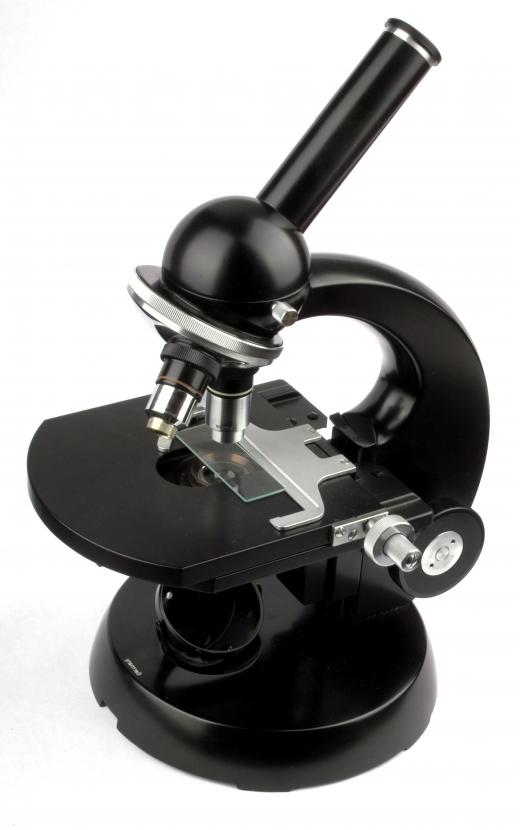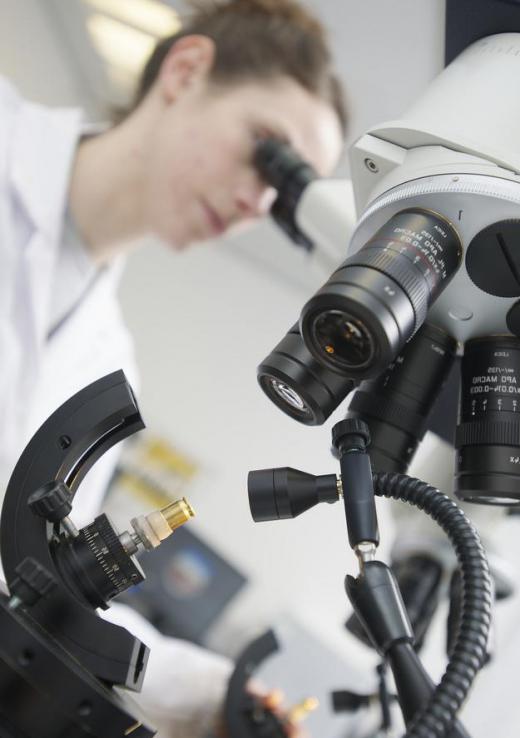What are the Different Parts of a Microscope?
 Dee Saale
Dee Saale
The parts of a microscope can vary from microscope to microscope. However, there are a few parts that are common to all microscopes. To begin with, microscopes require powerful light, especially those that intensify an image at the highest powers. Sometimes microscope lamps are used to achieve the goal of increased light, sometimes simply using a mirror will do the trick. If a mirror is one of the parts of a microscope, then use it to reflect light from an outside source through the bottom of the stage.
The stage is the flat platform that holds the slides in place with the help of stage clips. Sometimes a microscope will have a mechanical stage. If so, the stage will raise and lower by twisting one knob and move left or right by using a second knob. It is helpful to move the stage until the specimen is over the light below the stage. The item that will be inspected through the microscope is called the specimen.

There are usually several objective lenses located on a revolving nosepiece. The revolving nosepiece is one of the parts of a microscope that can hold two, three, four or more objective lenses – simple turn it to increase or decrease power. Usually the specimen is found using the lowest power. So, for example, if a scientist starts by finding the specimen with 4X magnification; then, the power can be increased incrementally to 10X, 40X or 100X, as needed. In addition, the eyepiece lens -- the lens the scientist looks through at the top of the microscope -- can be 10X magnification; consequently, the specimen can then be viewed at 100X, 400X or 1000X magnification when the power of the eyepiece lens and the objective lens are combined.

A few of the other parts of a microscope include the coarse adjustment knob and the fine adjustment knob. The coarse adjustment knob makes large scale adjustments to bring the specimen into focus. The fine adjustment knob makes minuscule adjustments and should be the only knob used when on the higher powers.
Other parts of a microscope are the condenser lens and the diaphragm or iris. The condenser lens focuses light onto a specimen. It works best if it is used under the higher powers, such as 400X or higher, and will make the image much sharper. The diaphragm or iris is a rotating platform underneath the stage. It has several sizes of holes and lets a variable amount of light through to the slide – a thicker specimen needs more light than a thinner specimen.
AS FEATURED ON:
AS FEATURED ON:













Discussion Comments
@croydon - Well, I actually would like to build my own microscope. They do tend to be pretty expensive, but most of the time second hand ones have something wrong with them. It would be cool to be able to put one together so I could get it cheaply and not have to worry about broken parts.
@KoiwiGal - Yeah, being able to name all the parts of a microscope is one of those things that seems pointless at high school, but you probably will need to know it if you do any kind of science in the future.
I think it's good to know them all anyway. It makes me think of those movies where the teacher makes the student craft their own sword or violin or whatever first, before they are allowed to use it. I'm not sure I could make my own microscope, but whenever anything goes wrong with it I can make a pretty good guess as to what's going on and that can really help matters.
However, now I've done some science classes at university, I realize that microscopes are pretty expensive, and that knowing how they work makes it much easier to use them.
Post your comments